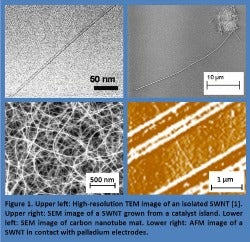Yanfei Yang
 Yanfei Yang earned a B.S. in Applied Optics in 1999 at Sichuan University, in Chengdu, China, and began graduate studies at Georgetown in the fall of 2002.
Yanfei Yang earned a B.S. in Applied Optics in 1999 at Sichuan University, in Chengdu, China, and began graduate studies at Georgetown in the fall of 2002.
As part of the Industrial Leadership in Physics curriculum, Yanfei spent a year working under the direction of Dr. Mark Covington at the Seagate Technologies Research Center in Pittsburgh, where she characterized the dynamical behavior of magnetization in nanopillar giant magnetoresistance devices [1]. These types of devices are used in the sensors that read data stored on hard drives, and the project was aimed at elucidating noise mechanisms that can adversely impact the performance of a hard disk drive recording system.
“Through the apprenticeship I gained hands-on experience with magnetism measurements in nanoscale devices, which enriched my background and knowledge in physics,” Yanfei says. She also developed a better understanding of the applied nature of research in a high-tech company.
After returning to Georgetown, Yanfei joined the research group of Professor Paola Barbara, participating in a NSF-funded project to explore possible superconductivity in carbon nanotubes. While her coursework at Georgetown had given her a good foundation in condensed matter physics, once she chose her research topic, Yanfei took advantage of the Washington Consortium of Universities’ cross registration program to take an advanced course on superconductivity at the University of Maryland in order to gain more specialized knowledge relevant to her research.
Carbon nanotubes (CNT) have many surprising properties, including very high electronic and thermal conductivity, superior strength, stiffness, and toughness along with elasticity. Moreover, due to their high aspect ratio (hundreds micrometers in length vs. few nanometers in diameter), they are nearly ideal 1D ballistic conductors. Yanfei’s dissertation research involved fabricating CNT field effect transistors and measuring their electrical properties as a function of temperature and field-induced doping. She found that a single nanotube in contact with normal metal electrodes may become superconducting below about 30 K [2,3].
After completing her thesis, entitled “Quantum Transport and Field Induced Superconductivity in Carbon Nanotubes.” Yanfei stayed on as a postdoctoral fellow in the research group of Professor Barbara. She is now a postdoctoral researcher based at NIST, working on a collaborative project between NIST and Georgetown. Reflecting on her graduate experience, Yanfei says “I am very grateful for the years learning and working in Professor Barbara’s research group.”
When she’s not doing physics, Yanfei enjoys all kinds of outdoor and indoor activities such as hiking, traveling, tennis, ice skating, reading, and drawing.
References:
[1] M. Covington, Y. Yang, T. M. Crawford, N. J. Gokemeijer, and M. A. Seigler. Magnetization dynamics driven by spin momentum transfer (Invited Paper). Proc. SPIE 5843, 11 (2005).
[2] J. Zhang, A. Tselev, Y. Yang, K. Hatton, S. E. Shafranjuk and P. Barbara. Zero-bias anomaly and possible superconductivity in single-walled carbon nanotube. Phys. Rev. B 74, 155414 (2006).
[3] Y. Yang, G. Fedorov, J. Zhang, A. Tselev, S. E. Shafranjuk and P. Barbara. Search for superconductivity at van Hove singularities in carbon nanotubes (Invited Paper). Manuscript submitted to Superconductor Science and Technology.
